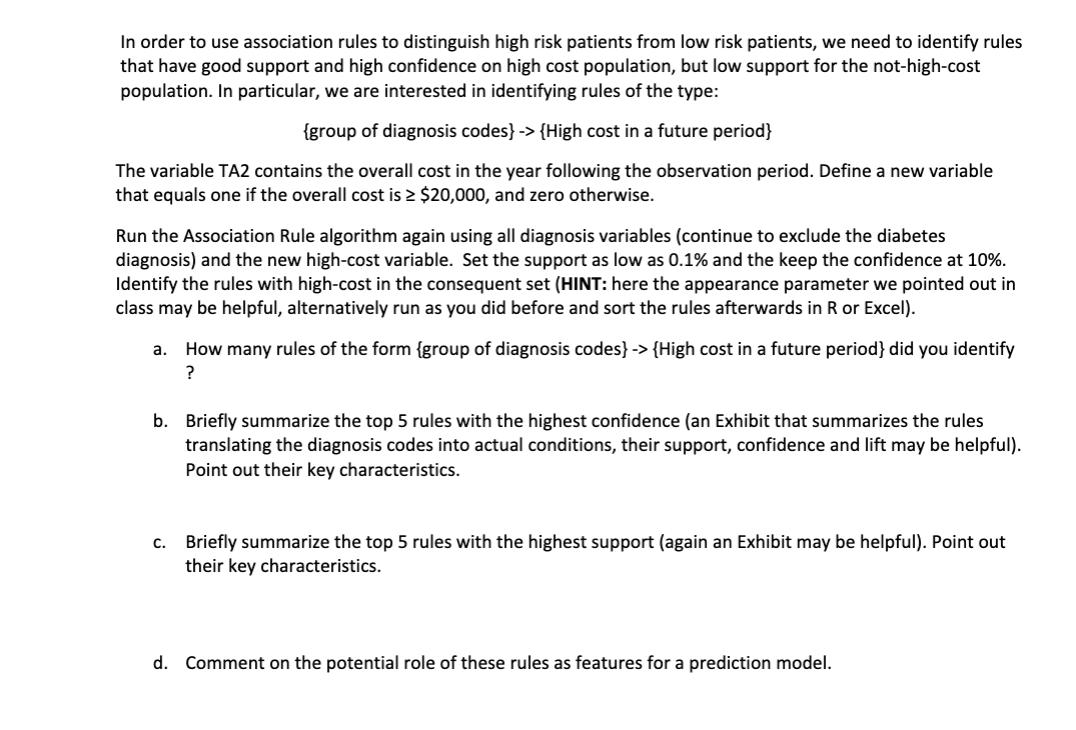Answered step by step
Verified Expert Solution
Question
1 Approved Answer
In order to use association rules to distinguish high risk patients from low risk patients, we need to identify rules that have good support

In order to use association rules to distinguish high risk patients from low risk patients, we need to identify rules that have good support and high confidence on high cost population, but low support for the not-high-cost population. In particular, we are interested in identifying rules of the type: {group of diagnosis codes} -> {High cost in a future period} The variable TA2 contains the overall cost in the year following the observation period. Define a new variable that equals one if the overall cost is $20,000, and zero otherwise. Run the Association Rule algorithm again using all diagnosis variables (continue to exclude the diabetes diagnosis) and the new high-cost variable. Set the support as low as 0.1% and the keep the confidence at 10%. Identify the rules with high-cost in the consequent set (HINT: here the appearance parameter we pointed out in class may be helpful, alternatively run as you did before and sort the rules afterwards in R or Excel). a. How many rules of the form {group of diagnosis codes} -> {High cost in a future period} did you identify ? b. Briefly summarize the top 5 rules with the highest confidence (an Exhibit that summarizes the rules translating the diagnosis codes into actual conditions, their support, confidence and lift may be helpful). Point out their key characteristics. c. Briefly summarize the top 5 rules with the highest support (again an Exhibit may be helpful). Point out their key characteristics. d. Comment on the potential role of these rules as features for a prediction model. In order to use association rules to distinguish high risk patients from low risk patients, we need to identify rules that have good support and high confidence on high cost population, but low support for the not-high-cost population. In particular, we are interested in identifying rules of the type: {group of diagnosis codes} -> {High cost in a future period} The variable TA2 contains the overall cost in the year following the observation period. Define a new variable that equals one if the overall cost is $20,000, and zero otherwise. Run the Association Rule algorithm again using all diagnosis variables (continue to exclude the diabetes diagnosis) and the new high-cost variable. Set the support as low as 0.1% and the keep the confidence at 10%. Identify the rules with high-cost in the consequent set (HINT: here the appearance parameter we pointed out in class may be helpful, alternatively run as you did before and sort the rules afterwards in R or Excel). a. How many rules of the form {group of diagnosis codes} -> {High cost in a future period} did you identify ? b. Briefly summarize the top 5 rules with the highest confidence (an Exhibit that summarizes the rules translating the diagnosis codes into actual conditions, their support, confidence and lift may be helpful). Point out their key characteristics. c. Briefly summarize the top 5 rules with the highest support (again an Exhibit may be helpful). Point out their key characteristics. d. Comment on the potential role of these rules as features for a prediction model.
Step by Step Solution
There are 3 Steps involved in it
Step: 1
a A total of 223 rules of the form group of diagnosis codes High cost in a future period were identified b Rule Diagnosis Codes Support Confidence Lif...
Get Instant Access to Expert-Tailored Solutions
See step-by-step solutions with expert insights and AI powered tools for academic success
Step: 2

Step: 3

Ace Your Homework with AI
Get the answers you need in no time with our AI-driven, step-by-step assistance
Get Started


